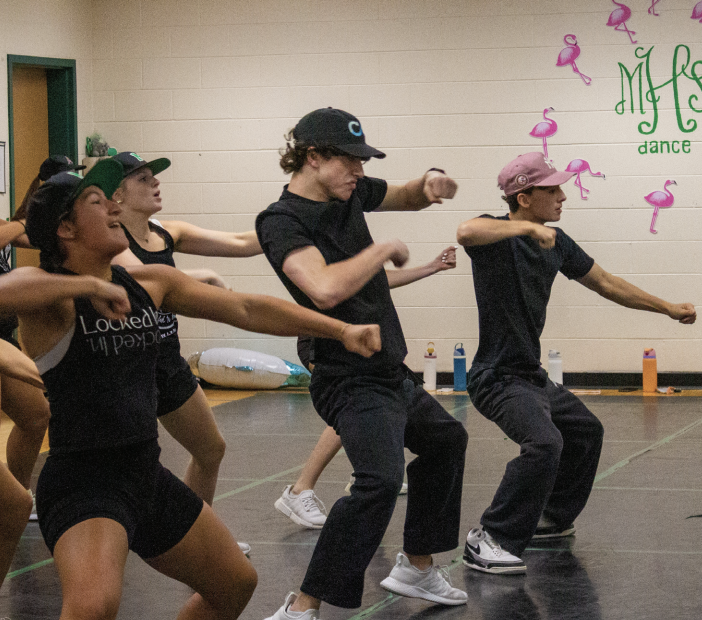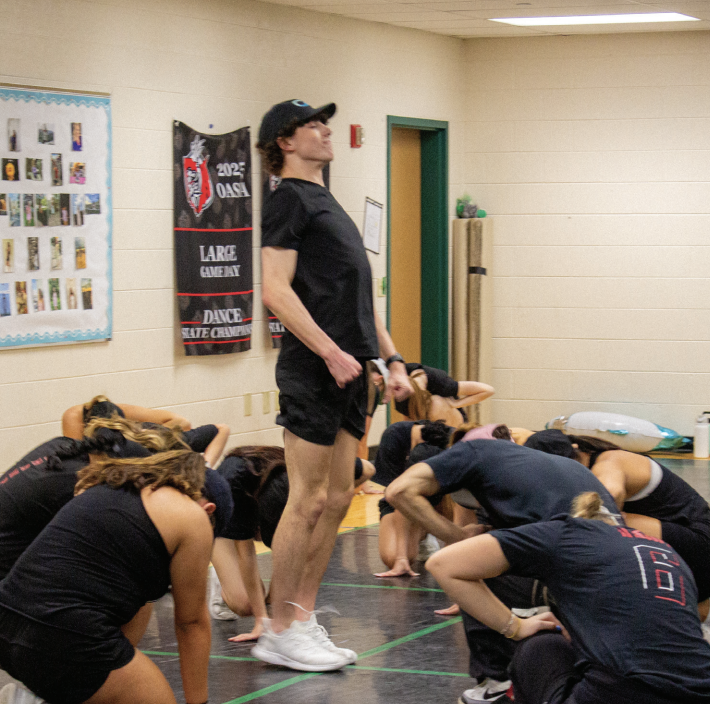Maria Ataya | The Chronicle
With every kick, turn and flip, Alex Hodges and Tighe Albers are doing more than just dancing; they are breaking stereotypes. Overcoming assumptions of what a dancer looks like, these two juniors provide the Mason High School (MHS) dance team with unique skills and energy.
Albers is currently competing as a first-year member on the dance team. Despite joining late in his high school career, Albers knew that this group of Mason dancers would be supportive of his goals.
“I was very busy [before joining the dance team] because I do both club dance and gymnastics,” Albers said. “But I saw how [successful] they were these past couple of years. Mason dance has evolved a lot. They have placed at nationals, [earned] many achievements and I decided I might as well join.”

Alex Hodges (middle) and Tighe Albers (right) hit their marks during a high-energy hip hop practice.
Growing up, Albers got used to being one of the only boys in a primarily female environment, with at most five boys dancing alongside him. But now, having joined the MHS team being one of the two boys, it’s different. Still, he takes it as an opportunity to represent not only himself but thousands of male dancers.
“[Gender] affects your spot on the team and where you are placed [on stage],” Albers said. “I think it’s good being a guy, there aren’t many guys that dance, and it shows that guys should dance.”
The conversations surrounding him as the new guy on the dance team show people that he can dance, and he has been able to do so for a while. He proves there’s more to him than what stereotypes might put forward. At times, he finds himself feeling pressured. To stay motivated, he surrounds himself with his teammates, knowing that they will support him during difficult times. Junior Addie Paxton, who dances alongside the boys, talks about the bond that they and the team have.
“We just have such good chemistry, so we all get along really well, we can tell each other everything and just be there for each other,” Paxton said.
This helps them approach challenges with confidence, knowing they don’t have to face negativity alone, playing a big part in ignoring the stigma for both Albers and Hodges.
“I definitely surround myself with my teammates, because they are a safe place that I can go to,” Albers said. “I can talk about anything with anyone on the team, and they’ll understand, and that always feels good.”
Hodges, who has been on the team since eighth grade, shares what it’s been like facing his challenges and experiencing these past couple of years. He remembers receiving hate at first, but ignored it to pursue the sport he loved.
“I got bullied by a lot of people in school,” Hodges said. “It’s just that I enjoyed it so much that it didn’t really matter to me.”
Paxton, who had been on the team with Hodges in eighth grade as well, witnessed the bullying and never once thought it was okay.
“I was on the middle school team with Hodges, and I witnessed some of the bullying, which was upsetting,” Paxton said. “I do think they face those kinds of stigma and stereotypes.”

Alex Hodges (middle) strikes a confident pose as the team rehearses.
Once Hodges reached his sophomore year, he had learned to ignore the hate, knowing that he got to do what he loved. What mattered most was the support he received from the people he cared about, rather than the judgment of people who didn’t know him. Hodges claimed that the hate slowly came to a stop when people realized that no matter what they said, he wouldn’t listen.
“Stereotypically, I’m not supposed to be doing dance or things such as dance, but it makes me happy, and I realized it’s better to be myself rather than try to fit a stereotype,” Hodges said.
As the MHS dance coach, Christina Huetter takes a special approach to managing the team, ensuring everyone feels valued and heard. Especially in supporting Hodges and Albers.
“It’s just more so navigating a very female-dominant sport and making sure that they feel comfortable and included,” Huetter said. “I just have very open communication with all the dancers. Try to make sure that they feel like they can come to me or my assistant coaches, Morgan and Holly.”
Regardless of the stigma, Hodges and Albers have proven to be strong assets to the team and bring a load of confidence to the team. They each showcase their strengths and help to create representation and variety in the choreography.
“They’re great role models to everyone on the team, everybody looks up to them, and they show a lot of responsibility,” Paxton said. “They are always just like hyping the team up.”
Huetter points out their strengths as well. As they make their way through the season, she notices how they have evolved, and its effect on the team.
“They obviously bring masculinity to the choreography, and they’re naturally stronger,” Huetter said. “This is my first year having Albers on the team, but Hodges is really growing into being a leader and is honing in on his craft as a dancer.”
Besides their impact on the team, their representation also sends a message to younger boys who may want to dance but are hesitant to join. Hodges, Albers and their coach all emphasize the importance of giving dance a try, regardless of fear or stigma. Together, their words all carry the same message: to take that first step.
“Try it,” Huetter said. “Go to a dance studio, see if you like it and don’t worry about what other people think.”






